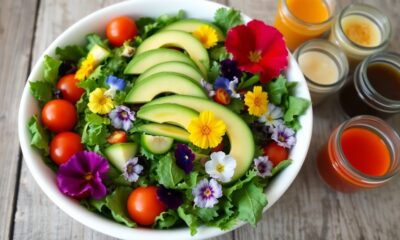Vietnamese Cuisine
Vietnamese Beef Jerky: the Perfect Snack With a Spicy Kick
Graced with a harmonious blend of savory, sweet, and spicy flavors, Vietnamese beef jerky is the ultimate snack that’ll have you craving more. Discover the secret to crafting this irresistible treat.

Bursting with savory, sweet, and spicy Vietnamese flavors, homemade beef jerky is the ultimate crowd-pleasing snack that'll transport your taste buds on a flavorful journey through the vibrant culinary traditions of Vietnam. Tracing its origins back to ancient times, this beloved treat features a delightful combination of marinades, spices, and drying techniques that result in a chewy, protein-packed snack with a satisfying kick of heat. Whether you're looking for a healthy on-the-go option or an impressive appetizer for your next gathering, Vietnamese beef jerky is sure to delight. And you'll find the key to crafting your own batch is just a few steps away.
Key Takeaways
- Vietnamese beef jerky is a beloved snack with a unique blend of savory, salty, and slightly sweet flavors, often with a spicy kick.
- The jerky is made by marinating beef in a mix of soy sauce, fish sauce, brown sugar, and spices, then dehydrating it for a chewy texture.
- Homemade Vietnamese beef jerky allows for customization of flavors and ingredients, making it a versatile and satisfying snack.
- This protein-packed jerky is a healthy and convenient option for on-the-go consumption, suitable for outdoor activities, lunchboxes, or social gatherings.
- Sharing and enjoying Vietnamese beef jerky can spark conversations about the rich culinary traditions and cultural heritage of Vietnam.
History

Vietnamese beef jerky has a rich history that dates back centuries.
It's believed that the origins of this delicious snack can be traced to the ancient Viets, a group of people who inhabited what's now modern-day Vietnam. These ingenious individuals discovered that drying and preserving beef was an excellent way to create a shelf-stable, portable food that could sustain them through their travels and daily activities.
Over the years, Vietnamese beef jerky has evolved, with different regions and families developing their own unique recipes and flavors. Some use a blend of savory spices, while others add a touch of sweetness.
No matter the specific preparation, one thing remains constant: the mouthwatering combination of tender, flavorful beef and a satisfying chew. These qualities make beef chews a popular choice for meat lovers everywhere. In addition to the delicious taste and texture, beef chews also offer the added benefits of ginger chews. Ginger is known for its digestive and anti-inflammatory properties, making it a great addition to any savory snack. These ginger chews can help soothe the stomach and provide a burst of flavor to the already delectable beef.
Today, Vietnamese beef jerky continues to be a beloved snack, enjoyed by people around the world. Its rich history and delectable taste make it a truly special culinary treasure.
Recipe

Vietnamese Beef Jerky
Recipe
Beef jerky is a beloved snack in Vietnam, offering a delightful blend of savory, salty, and slightly sweet flavors. This recipe captures the essence of traditional Vietnamese beef jerky, using a combination of spices and marinades to create a mouthwatering final product.
Preparing the jerky at home allows you to control the ingredients and customize the flavor to your liking. Whether you enjoy it as a standalone snack or incorporate it into your cooking, this homemade Vietnamese beef jerky is sure to satisfy your cravings.
Ingredients:
- 2 lbs (1 kg) beef flank steak or sirloin, thinly sliced
- 1/4 cup (60 ml) soy sauce
- 2 tablespoons (30 ml) fish sauce
- 2 tablespoons (30 ml) brown sugar
- 2 teaspoons (10 ml) garlic powder
- 1 teaspoon (5 ml) ground black pepper
- 1/2 teaspoon (2.5 ml) cayenne pepper (optional, for spicier jerky)
Instructions:
In a large bowl, combine the soy sauce, fish sauce, brown sugar, garlic powder, and black pepper (and cayenne pepper, if using). Add the thinly sliced beef and toss to coat evenly. Cover and refrigerate for at least 4 hours, or up to 24 hours, to allow the flavors to marinate.
Preheat your oven to 175°F (80°C) or use a dehydrator set to the same temperature. Arrange the marinated beef slices in a single layer on a baking sheet or dehydrator trays, making sure they aren't overlapping.
Dry the beef in the oven or dehydrator for 4-6 hours, or until the jerky is dry and leathery, but still pliable.
Tips:
- For a chewier texture, slice the beef against the grain. For a more tender jerky, slice with the grain.
- You can adjust the spices and seasonings to suit your personal taste preferences.
- Store the finished Vietnamese beef jerky in an airtight container at room temperature for up to 2 weeks.
Cooking Steps

First, you'll marinate the beef in a savory soy sauce mixture.
Then, you'll dehydrate the meat at a low temperature to lock in the flavors.
Next, carefully slice the beef into thin, uniform strips.
After that, give your jerky a spicy kick by coating it with chili oil.
Step 1. Marinate Meat in Soy Sauce Mixture

Next up, you'll want to grab a large bowl or resealable bag and whisk together the soy sauce, fish sauce, brown sugar, garlic, and spices.
This savory marinade is the secret to giving your Vietnamese beef jerky its signature flavor!
Once the mixture is well combined, go ahead and add your thinly sliced beef strips.
Make sure each piece is coated evenly in the tantalizing blend.
Cover the bowl or seal the bag and pop it in the fridge for at least 30 minutes, or up to overnight.
The longer you let the meat marinate, the more intense the flavors will become.
When you're ready to start dehydrating, simply remove the beef from the marinade and arrange the strips in a single layer on your dehydrator trays or baking sheets.
Be sure to leave a little space between each piece so the hot air can circulate and dry them out to jerky perfection.
Now you're on your way to creating the ultimate Vietnamese-style beef jerky!
Step 2. Dehydrate Meat at Low Temperature
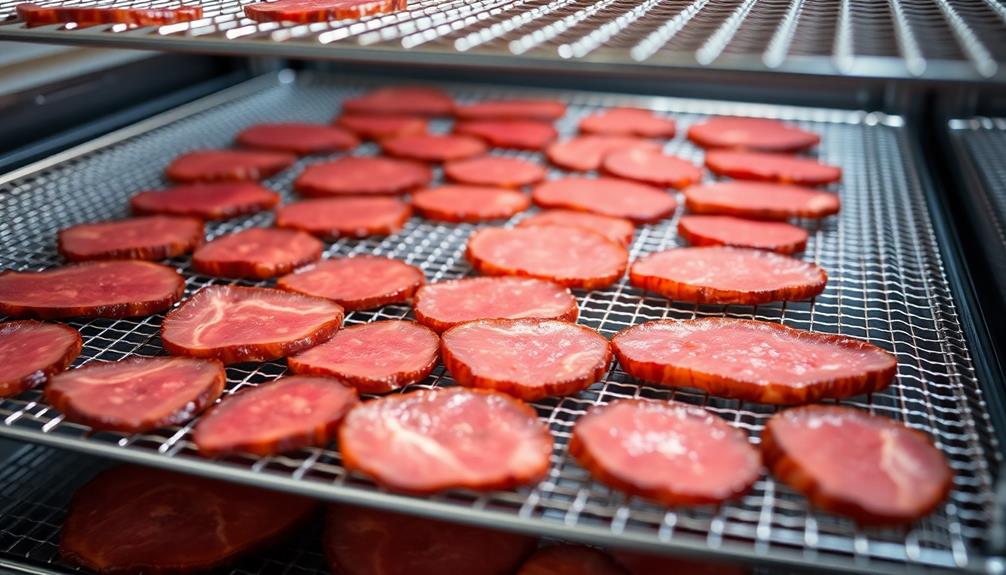
With the marinated beef strips ready, it's time to start dehydrating them. Turn on your food dehydrator and set the temperature to 155°F. This low temperature is key – it'll slowly dry out the meat without cooking it.
Ensure that your dehydrator is clean and well-maintained for optimal performance, as regular cleaning is essential for optimal performance of air purifiers.
Carefully arrange the strips on the dehydrator trays, making sure they don't overlap. This allows the hot air to circulate evenly around each piece. Let the jerky dehydrate for 4-6 hours, checking on it occasionally. The exact time can vary based on the thickness of your strips.
Once the jerky is dry and leathery, with no moisture left, it's ready! Transfer the crispy, flavorful strips to an airtight container.
Store at room temperature for up to 2 weeks. Enjoy this delicious, authentic Vietnamese beef jerky as a satisfying, protein-packed snack. The low-and-slow dehydration method ensures the perfect texture and taste every time.
Step 3. Slice Meat Into Thin Strips

Grab a sharp knife and carefully slice the marinated beef into even, thin strips about 1/4-inch thick. This step is crucial for achieving the perfect texture and mouthfeel of your Vietnamese beef jerky. You want the strips to be uniform in size so they'll dry evenly.
Take your time and pay close attention as you slice. Gently press down on the meat with your free hand to keep it steady. Slice across the grain of the meat, creating long, thin strips that will be easy to chew.
Once you've sliced all the beef, arrange the strips in a single layer on your dehydrator trays or baking sheets. Make sure the strips aren't overlapping, as you want maximum airflow to help them dry quickly and evenly.
With the meat prepped, you're one step closer to enjoying the bold, savory flavors of authentic Vietnamese beef jerky. Get ready for a snack that's packed with spicy, umami goodness!
Step 4. Coat Jerky With Chili Oil
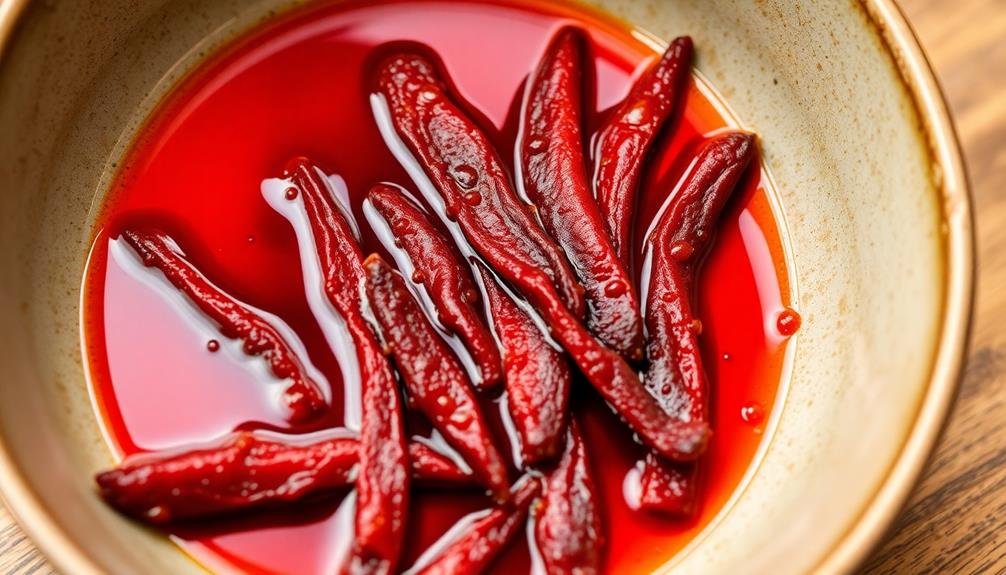
After you've sliced the beef into uniform strips, it's time to coat them in a fragrant chili oil. This special oil adds a fiery kick that will tantalize your taste buds!
First, gather your ingredients: chili flakes, garlic, and a neutral oil like vegetable or peanut. In a small saucepan, gently heat the oil over medium heat.
Add the chili flakes and garlic, and let them sizzle for a minute or two, stirring constantly. Remove the pan from the heat and allow the oil to cool slightly.
Now, place your sliced beef in a large bowl. Drizzle the spicy chili oil over the strips, making sure to coat them evenly.
Use your hands to gently massage the oil into the meat, ensuring every piece is infused with the bold, zesty flavors.
Let the jerky rest for a few minutes, allowing the flavors to meld. Then, you're ready to enjoy your homemade Vietnamese beef jerky with a delightful chili oil kick!
Step 5. Hang Jerky to Dry Completely
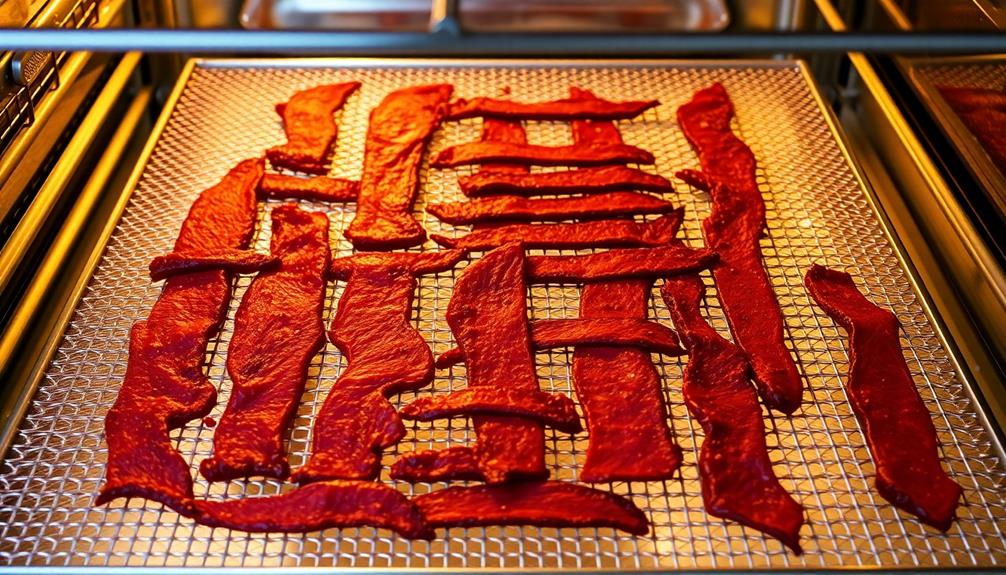
Now that you've coated the jerky in the fragrant chili oil, it's time to hang it up to dry completely. This is a crucial step to ensure your Vietnamese beef jerky turns out perfectly crispy and flavorful.
Grab some sturdy strings or fishing line and begin carefully hanging the jerky pieces, making sure they're spaced out and not touching each other. This allows the air to circulate freely and helps the jerky dry evenly.
Find a warm, well-ventilated spot, like a sunny windowsill or a spare corner of your kitchen, and let the jerky hang for 8-12 hours, or until it's completely dried out.
Keep an eye on it, and if any pieces start to look a little too dry, simply remove them from the line.
Once fully dried, your jerky will have a delightful, chewy texture that's bursting with that delicious Vietnamese spice blend.
Get ready to enjoy a tasty, healthy snack that's perfect for sharing with family and friends!
Final Thoughts

As you've explored the wonders of Vietnamese beef jerky, what final thoughts come to mind?
You've learned how to perfectly craft this delicious, protein-packed snack, from marinating the meat to hanging it to dry. Now, you can't wait to share this tasty treat with your friends and family!
The vibrant flavors and satisfying chewiness of Vietnamese beef jerky make it the perfect on-the-go snack.
Whether you're packing it for a hike, throwing it in your lunchbox, or enjoying it as an evening snack, this jerky is sure to delight. Plus, the spicy kick adds an exciting twist that sets it apart from regular beef jerky.
Celebrating the rich culinary traditions of Vietnam, this jerky is a delightful way to explore new flavors.
Get ready to wow your loved ones with your newfound jerky-making skills, and savor the joy of sharing this incredible snack together.
Frequently Asked Questions
What Is the Shelf Life of Vietnamese Beef Jerky?
The shelf life of Vietnamese beef jerky can vary, but it typically lasts 2-3 weeks when stored in an airtight container at room temperature. If properly refrigerated, it may last up to 6 months.
Can the Spice Level of the Jerky Be Adjusted?
Yes, you can adjust the spice level of the jerky. Most manufacturers offer varying degrees of heat, from mild to extra spicy, allowing you to choose the level that suits your taste preferences.
Is Vietnamese Beef Jerky Gluten-Free?
Yes, Vietnamese beef jerky is typically gluten-free. The marinade and seasonings used in its preparation don't contain wheat or gluten-based ingredients. This makes it a safe snack option for those following a gluten-free diet.
Where Can I Purchase High-Quality Vietnamese Beef Jerky?
You can purchase high-quality Vietnamese beef jerky from specialty Asian grocery stores, online retailers that specialize in Vietnamese snacks, or directly from Vietnamese-owned jerky producers. Look for brands that use authentic Vietnamese seasonings and techniques.
How Does Vietnamese Beef Jerky Differ From Other Jerky Varieties?
Vietnamese beef jerky differs from other varieties in its intense, complex flavors. It's often marinated in a mixture of fish sauce, garlic, and chili peppers, giving it a unique, fiery taste you won't find in traditional American-style jerky.
Mai is a passionate chef specializing in Vietnamese cuisine. From fragrant pho to fresh spring rolls and banh mi, Mai’s dishes showcase the balance of sweet, salty, sour, and spicy that defines Vietnamese cooking. Her recipes emphasize fresh herbs, flavorful broths, and the light, vibrant ingredients that make Vietnamese food so special.
Vietnamese Cuisine
Vietnamese Nem Chua: The Savory Fermented Snack You’ll Love
Acaptivating blend of sweet, sour, and umami flavors, Nem Chua is a beloved Vietnamese fermented pork snack that’ll have your taste buds craving more. Learn the steps to craft this Vietnamese treasure at home.

Get ready to dive into the savory world of Nem Chua, a beloved Vietnamese culinary delight! This fermented pork snack boasts a tantalizing blend of sweet, sour, and umami flavors that'll have your taste buds dancing. Originating in northern Vietnam centuries ago, Nem Chua has become a cultural staple, often shared during festive gatherings. The key lies in the meticulous fermentation process, where the pork develops its signature chewy texture and captivating aroma. Wrap it in banana leaves, pair it with pickled veggies, and prepare to embark on a flavor adventure that'll leave you craving more. Want to learn the steps to craft this Vietnamese treasure at home?
Key Takeaways
- Nem Chua is a traditional Vietnamese fermented pork snack with a unique savory, sour, and umami flavor profile.
- The fermentation process is essential for developing the distinct taste and chewy texture of Nem Chua.
- Nem Chua is often served with pickled vegetables, enhancing the contrast of flavors and textures.
- Nem Chua is a culturally significant dish, widely enjoyed during festive occasions and family gatherings in Vietnam.
- Preparing Nem Chua at home involves a straightforward process, allowing for customization to personal taste preferences.
History
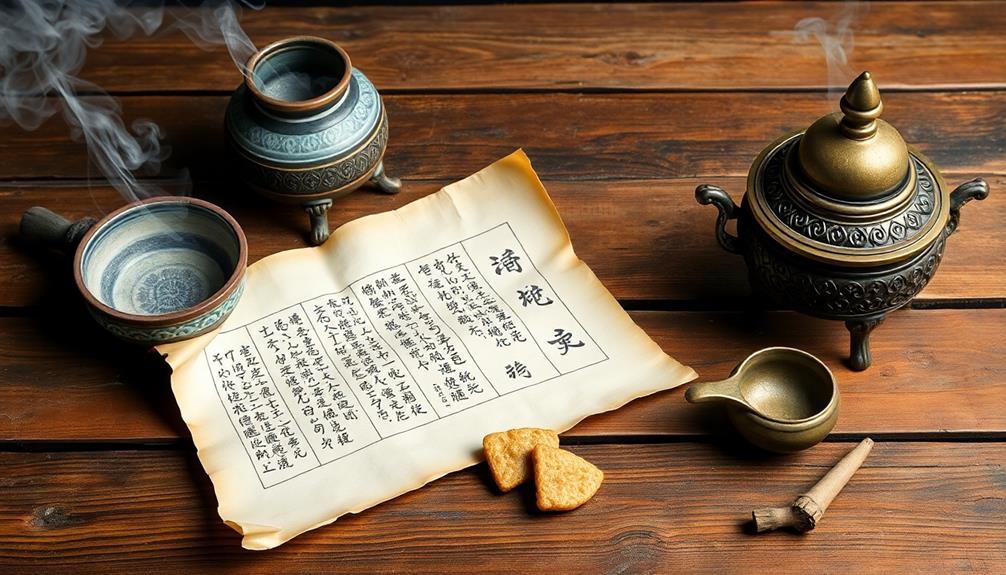
Nem Chua, the beloved Vietnamese fermented pork sausage, traces its roots back to the northern regions of the country. This savory snack has been a beloved part of Vietnamese cuisine for centuries, passed down through generations.
The origins of Nem Chua can be traced to the 15th century, when the dish was first mentioned in historical records. Back then, it was a simple affair – just pork, salt, and rice bran. As the dish evolved, additional ingredients like chilies, garlic, and fish sauce were added, creating the distinct flavor profile we know and love today.
Traditionally, Nem Chua was a staple food for farmers and laborers, providing a protein-packed and portable snack. Over time, it became a beloved part of Vietnamese culture, often served at festivals, celebrations, and family gatherings.
Today, Nem Chua remains a cherished treat, enjoyed by people of all ages across the country.
Recipe

Nem Chua, also known as Vietnamese cured meat, is a popular snack food in Vietnam. It's a fermented meat product that has a unique and complex flavor profile, combining the savory, salty, and slightly sour notes of the cured meat with the crunch of vegetables and the heat of chili peppers.
The traditional method of making Nem Chua involves carefully selecting and preparing the ingredients, followed by a meticulous curing process that can take several days. While it may seem like a laborious task, the resulting flavor and texture of the finished product make it well worth the effort.
Ingredients:
- 2 lbs ground pork
- 1 tbsp salt
- 1 tbsp sugar
- 1 tbsp fish sauce
- 1 tsp ground black pepper
- 2 cloves garlic, minced
- 2 Thai chili peppers, finely chopped
- 1 cup shredded carrots
- 1 cup shredded daikon radish
- 1 cup finely chopped green onions
- Banana leaves or rice paper wrappers, for serving
Instructions:
In a large bowl, combine the ground pork, salt, sugar, fish sauce, black pepper, garlic, and Thai chili peppers. Mix well until all the ingredients are evenly distributed.
Cover the bowl and refrigerate for at least 24 hours, or up to 48 hours, to allow the flavors to develop.
After the curing process, add the shredded carrots, daikon radish, and green onions to the pork mixture. Stir to combine.
Divide the mixture into small portions and wrap them in banana leaves or rice paper wrappers. Secure with toothpicks or string.
Tips:
For best results, let the wrapped Nem Chua ferment at room temperature for an additional 2-3 days before serving. This will further enhance the flavor and texture of the cured meat.
Serve Nem Chua as a snack or appetizer, accompanied by fresh herbs, vegetables, and dipping sauces like fish sauce, chili sauce, or nuoc cham.
Cooking Steps

Combine the juicy pork, fragrant herbs, and zesty spices in a bowl.
Wrap the pork mixture tightly in banana leaves and let it ferment for 3 to 5 days.
Once it's ready, slice the flavorful, fermented pork and serve it alongside tasty pickled veggies.
Step 1. Combine Pork, Herbs, and Spices

With the pork, herbs, and spices at the ready, you can now bring them together to craft the quintessential filling for the Vietnamese nem chua. First, dice the pork into small, bite-sized pieces, ensuring even cooking and texture.
Next, chop the fragrant cilantro, savory garlic, and zesty lime leaves, blending their flavors to create a delightful aroma. Don't forget the warm spices – a pinch of ground black pepper and a dash of chili powder will add a subtle kick to the mixture.
Now, combine all the ingredients in a large bowl, using your hands to thoroughly mix them together. Knead the mixture, working the flavors into the pork until it's well-incorporated.
You'll want the filling to be cohesive, with the herbs and spices evenly distributed. Taste as you go, adjusting the seasoning to your liking. With the perfect balance of salty, sour, and spicy, you're ready to stuff the nem chua and begin the fermentation process.
Step 2. Wrap Pork Mixture in Banana Leaf

Grab a clean banana leaf and gently lay it flat on your work surface. This large, green leaf will act as the wrapping for your savory pork mixture.
Spoon a generous portion of the seasoned pork onto the center of the leaf. Fold the sides of the leaf over the pork, then roll it up tightly, creating a neat little package. Secure the roll with a toothpick or a thin strip of the leaf.
Now, repeat this process with the remaining pork mixture and leaves. Line them up neatly as you go. These handheld wraps are perfect for sharing with friends and family at your next gathering.
The fragrant banana leaf adds an extra layer of flavor and aroma. Once your nem chua are all wrapped up, you're ready for the final step – fermentation! Get ready to enjoy this delicious Vietnamese specialty.
Step 3. Ferment Wrapped Pork for 3-5 Days

To ferment the wrapped pork, place the neatly arranged nem chua packages in a large, clean container. Cover them completely with a brine solution made from salt and water. Be sure the pork is fully submerged.
Now, let the container sit in a warm spot for 3-5 days. As the pork ferments, you'll notice a tantalizing sour aroma. This is a good sign – the flavors are developing!
During this time, you'll need to check on the container daily. Skim off any foam or scum that rises to the surface. This helps keep the fermentation process healthy.
When the 3-5 day mark arrives, your nem chua is ready! The pork should have a firm, chewy texture and a delightful sour-savory taste. Unwrap the leaves and enjoy this classic Vietnamese snack. The fermentation process has transformed the pork into a delectable treat!
Step 4. Slice Fermented Pork Before Serving
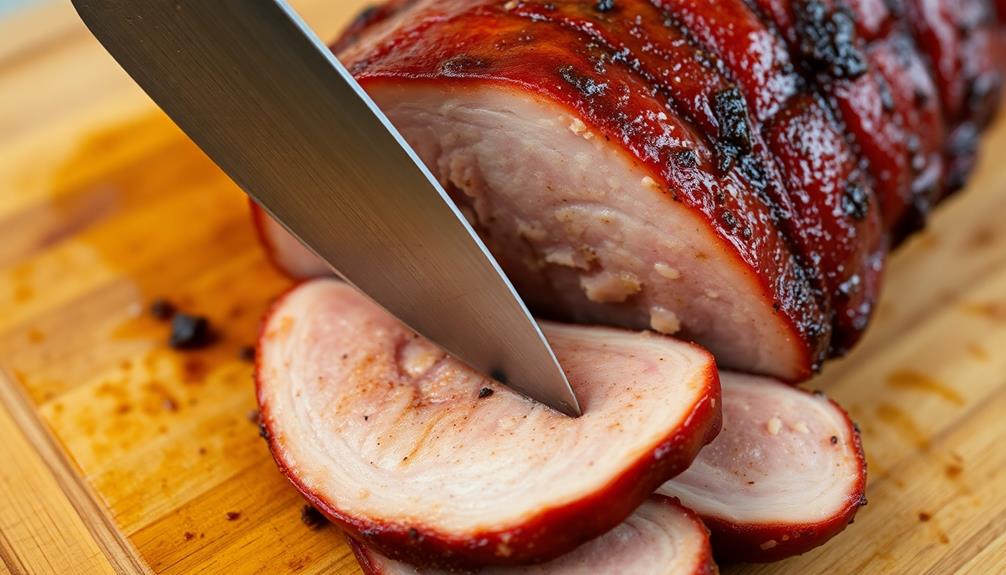
The fermented pork's firm, chewy texture and delightful sour-savory flavor are ready to be enjoyed. Before serving, you'll want to slice the pork into thin, bite-sized pieces. This allows everyone to easily pick up and savor each delectable morsel.
First, grab a sharp knife and carefully slice the fermented pork log into discs about 1/4-inch thick. Try to make the slices as even as possible for a neat, uniform presentation. If the pork seems a bit stubborn, don't be afraid to apply a gentle rocking motion to the knife as you cut through.
Once sliced, arrange the pork pieces on a serving platter or plate. You can garnish them with:
- Thinly sliced chilies for a pop of color and heat
- Chopped cilantro or mint leaves for a fresh, herbal note
- Crushed peanuts for a satisfying crunch
Now your Vietnamese nem chua is ready to be shared and savored by all! The combination of flavors and textures is truly irresistible.
Step 5. Serve With Pickled Vegetables

Pairing your sliced Vietnamese nem chua with a selection of pickled vegetables takes the dish to new flavor heights. The tangy, crunchy veggies provide a perfect foil to the rich, savory pork. Try thinly sliced carrots, daikon radish, and cucumbers – they'll add a refreshing zing that balances the bold fermented taste of the nem chua.
Prepare the pickled vegetables in advance for maximum flavor. Simply mix the sliced veggies with a brine of vinegar, sugar, and salt. Let them sit for at least 30 minutes, or up to a few days in the fridge. The longer they pickle, the more intense the flavors will become.
Arrange the pickled veggies on a platter alongside your sliced nem chua. Encourage your guests to build their own little bites, layering the pork and crunchy veggies on a crisp lettuce leaf or rice paper wrap.
The contrasting textures and tastes will delight your senses and have everyone coming back for more.
Final Thoughts

Ultimately, Nem Chua's versatility and captivating flavors make it a Vietnamese culinary gem. You can enjoy this savory fermented snack any time, whether as an appetizer, a quick bite, or even a meal accompaniment.
Its complex taste is sure to delight your senses – the perfect balance of sweet, sour, and umami.
What's more, Nem Chua is incredibly easy to prepare at home. With a bit of patience and the right ingredients, you can recreate this beloved treat and share it with family and friends.
Imagine the joy of gathering around a table, dipping into the tangy pork, and savoring each flavorful bite. It's a moment of pure Vietnamese culinary bliss.
Frequently Asked Questions
How Long Does It Take to Ferment Vietnamese Nem Chua?
It typically takes 2-3 days to ferment Vietnamese nem chua. The fermentation process allows the flavors to develop and the texture to become firm. Be patient, as rushing it won't give you the same authentic taste.
What Are the Health Benefits of Eating Vietnamese Nem Chua?
Eating Vietnamese nem chua can provide you with beneficial probiotics, boost your immune system, and aid digestion. It's also a good source of protein and may even help reduce inflammation in your body.
Can I Store Leftover Vietnamese Nem Chua, and if So, How?
Yes, you can store leftover Vietnamese nem chua. Keep it in an airtight container in the refrigerator for up to a week. The fermentation process will continue, so the flavor may change slightly, but it'll still be tasty.
Is Vietnamese Nem Chua Safe for Pregnant Women to Consume?
Consuming fermented foods like Vietnamese nem chua during pregnancy is generally safe, but it's best to consult your doctor. They can provide personalized guidance on any potential risks or precautions you should consider.
Where Can I Purchase the Necessary Ingredients to Make Vietnamese Nem Chua?
To make Vietnamese nem chua, you can purchase the necessary ingredients like ground pork, rice paper, and spices from Asian grocery stores or online specialty retailers. Be sure to follow proper food safety guidelines when handling raw meat.
Mai is a passionate chef specializing in Vietnamese cuisine. From fragrant pho to fresh spring rolls and banh mi, Mai’s dishes showcase the balance of sweet, salty, sour, and spicy that defines Vietnamese cooking. Her recipes emphasize fresh herbs, flavorful broths, and the light, vibrant ingredients that make Vietnamese food so special.
Vietnamese Cuisine
Gỏi Tôm Thịt: Vietnamese Shrimp and Pork Salad
With fresh shrimp, tender pork, and vibrant veggies, Gỏi Tôm Thịt offers a taste of Vietnamese culture that you won’t want to miss!

Gỏi Tôm Thịt is a tasty Vietnamese salad that combines fresh shrimp and tender pork, making a delightful dish perfect for sharing! You start by preparing the shrimp and pork, then chop fresh herbs and mix a zesty dressing. Next, you assemble everything on a bed of greens, adding vibrant veggies for crunch. Finally, sprinkle roasted peanuts on top for an extra layer of flavor! This colorful salad is not just delicious; it also represents togetherness in Vietnamese culture, making it a wonderful choice for gatherings. Stick around, and you'll discover more exciting details about this refreshing dish!
Key Takeaways
- Gỏi Tôm Thịt is a Vietnamese salad featuring a combination of fresh shrimp, pork, and vibrant vegetables, offering a refreshing taste experience.
- The dish symbolizes togetherness and love, often enjoyed during family gatherings and celebrations in Vietnamese culture.
- Preparation involves rinsing, peeling shrimp, chopping fresh herbs, mixing a zesty dressing, and assembling ingredients for a colorful presentation.
- Customization options include adding favorite vegetables, proteins, and adjusting spice levels to suit personal preferences.
- Best served chilled or at room temperature, Gỏi Tôm Thịt pairs well with rice or rice noodles for a complete meal.
History
Vietnamese shrimp and pork salad, known as "Gỏi tôm thịt," boasts a rich history that reflects the vibrant culinary traditions of Vietnam. This delicious dish has roots that go back centuries, blending flavors and ingredients from various regions. You'll find that its creation was influenced by the fresh ingredients available in the lush landscapes of Vietnam, like shrimp from the ocean and pork from local farms.
As you explore the history of Gỏi tôm thịt, you'll discover how it embodies the essence of Vietnamese cooking. Families would gather to prepare this salad, celebrating special occasions and sharing stories while enjoying the meal together. It's not just food; it's a symbol of togetherness and love.
Over time, different regions of Vietnam have added their unique twists, making each version special. The dish often reflects local tastes, showcasing the creativity and resourcefulness of Vietnamese cooks.
Ingredients:
- 200g shrimp, peeled and deveined
- 200g pork tenderloin, thinly sliced
- 1 cup lettuce, shredded
- 1 cup cabbage, shredded
- 1 carrot, julienned
- 1 cucumber, thinly sliced
- 1/2 cup fresh herbs (mint, cilantro, and basil)
- 2 tablespoons roasted peanuts, crushed
- 3 tablespoons fish sauce
- 2 tablespoons lime juice
- 1 tablespoon sugar
- 1 clove garlic, minced
- 1 chili pepper, sliced (optional)
Cooking Instructions:
Start by boiling a pot of water and adding the shrimp, cooking until they turn pink (about 2-3 minutes) before removing them and placing them in an ice bath to stop the cooking process.
In the same pot, add the pork and cook until fully cooked through (about 5-7 minutes). Once cooked, let the pork cool before slicing it into thin strips.
In a large bowl, combine the lettuce, cabbage, carrot, cucumber, shrimp, and pork. In a separate bowl, whisk together the fish sauce, lime juice, sugar, garlic, and chili pepper to create the dressing.
Pour the dressing over the salad, toss to combine, and top with fresh herbs and crushed peanuts just before serving.
Extra Tips:
For an authentic touch, consider using grilled pork instead of boiled pork for a smoky flavor.
Additionally, feel free to customize the salad with your favorite vegetables or herbs—Thai basil, for example, can add a unique twist. If you prefer a bit more heat, adjust the amount of chili pepper in the dressing to cater to your taste.
Lastly, let the salad sit for a few minutes after dressing to allow the flavors to meld together before serving.
Cooking Steps
To prepare this delicious shrimp and pork salad, you'll want to start by gathering all your ingredients. You'll need shrimp, pork, fresh herbs, carrots, and a few other tasty items. Once you have everything, it's time to cook!
First, boil a pot of water and add the shrimp. Cook them for about 2-3 minutes until they're pink and firm. Then, take them out and let them cool.
Next, cook the pork in the same water until it's fully cooked. After that, slice the pork into thin pieces.
Now, grab a big bowl and mix together your shrimp, sliced pork, grated carrots, and fresh herbs like mint and cilantro. Don't forget to add your favorite dressing to make it extra yummy!
Toss everything together gently so the flavors blend well.
Step 1. Prepare Fresh Shrimp
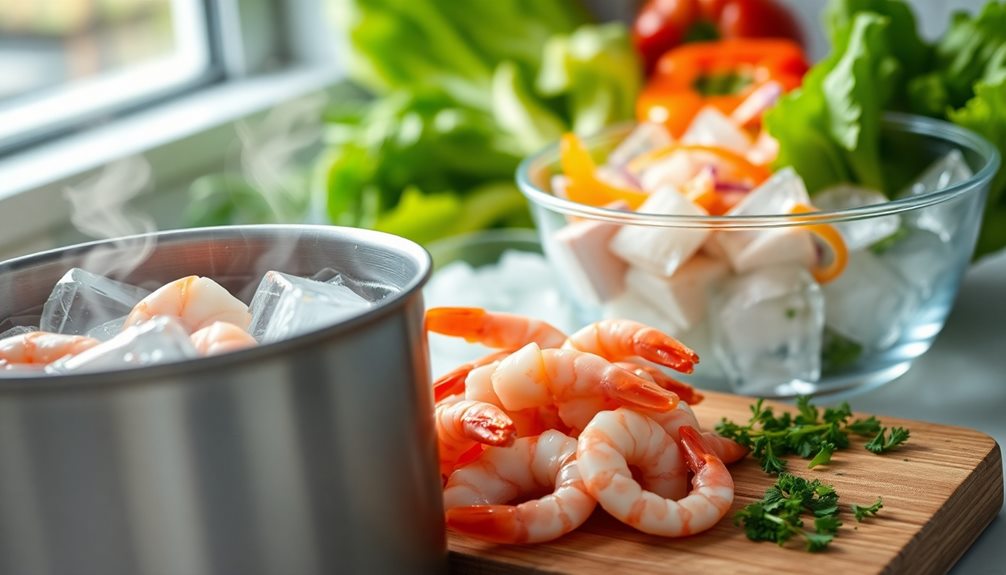
Typically, you'll want to start by rinsing the fresh shrimp under cold running water to remove any impurities. This step is super important because it helps keep your salad clean and tasty!
Once you've rinsed them, it's time to peel the shrimp. Hold the shrimp in one hand and gently pull off the shell with the other. Don't forget to remove the legs too!
After peeling, you'll need to devein the shrimp. Look for a dark line along the back; that's the vein. Using a small knife, make a shallow cut along the back and carefully pull out the vein. This makes your shrimp look nice and keeps them yummy.
Now, you can give the shrimp one more rinse to ensure they're clean. If you're feeling adventurous, you can marinate them in a bit of lime juice and salt for extra flavor! Let them sit for about 15 minutes to soak up all those tasty flavors.
When you're done, you'll have fresh shrimp ready to add to your Vietnamese salad, and everyone will love it! Enjoy the process, and get ready for some deliciousness!
Step 2. Chop Fresh Herbs Finely

Once you've prepared your shrimp, it's time to chop the fresh herbs finely, as they'll add vibrant flavor and freshness to your salad. Start by gathering your herbs, like cilantro, mint, and basil. These herbs are going to make your dish smell amazing!
If you're looking to enhance the freshness even further, consider incorporating a few drops of essential oils for hair growth like rosemary oil, which can promote a healthy scalp environment.
Rinse them under cool water to remove any dirt. After that, gently pat them dry with a paper towel. Now, grab a cutting board and a sharp knife. Pick up a handful of your favorite herb, and with a steady hand, start chopping it into small pieces. Remember, the smaller the pieces, the more flavor you'll release!
If you're using multiple herbs, you can chop them together for a delightful mix. Just be careful when you're chopping—keep your fingers tucked in!
Once you've chopped enough herbs, take a moment to smell them. Doesn't it smell fantastic?
Now, you're ready to add these flavorful bits into your salad. These fresh herbs not only taste great, but they also make your dish look colorful and inviting. Enjoy the process, and get excited about how delicious your salad will be!
Step 3. Mix Dressing Ingredients Thoroughly

With all your fresh herbs ready, it's time to whip up the dressing that will tie your Vietnamese shrimp and pork salad together. Start by gathering all the ingredients you'll need: fish sauce, lime juice, sugar, and minced garlic. Each ingredient brings a burst of flavor that makes this dressing special!
In a bowl, combine three tablespoons of fish sauce, the juice of two limes, and a tablespoon of sugar. Stir it all together until the sugar dissolves completely. This part is super important because it helps balance the salty, sour, and sweet flavors.
Next, add in a clove of minced garlic for that zesty kick.
Now, if you like a bit of heat, feel free to toss in some sliced chili for an extra burst of flavor. Mix everything well, making sure all the ingredients are blended smoothly.
Don't be afraid to taste it! You can adjust the levels of lime or sugar to suit your taste. Once it's just right, set it aside. You're now one step closer to enjoying your delicious salad!
Step 4. Assemble Salad Ingredients Together

Now that your dressing is ready, it's time to assemble your salad ingredients. First, grab a big bowl to hold all those delicious flavors!
Start by adding your fresh greens, like lettuce or cabbage. These crunchy veggies will give your salad a great base. Next, toss in the cooked shrimp and sliced pork. They're the stars of this dish and will make it super tasty!
Now, it's time for some color! Add in vibrant veggies like shredded carrots and thinly sliced bell peppers. Don't forget the fresh herbs! Chopped mint and cilantro will make your salad smell amazing and add a burst of flavor.
Once everything is in the bowl, gently mix it all together. You want the ingredients to be evenly distributed, so every bite is flavorful.
Finally, drizzle your prepared dressing over the salad. Make sure you coat everything well! It's okay if you save a little dressing for later; you can always add more if needed.
Now, step back and admire your beautiful creation. It's almost time to dig in! Just make sure to stir it one last time before serving.
Enjoy your delicious Vietnamese shrimp and pork salad!
Step 5. Garnish With Roasted Peanuts

To add the finishing touch to your Vietnamese shrimp and pork salad, sprinkle some roasted peanuts on top. This simple step makes your dish not only look fantastic but also adds a delightful crunch.
First, grab a handful of roasted peanuts. You can buy them already roasted or make your own by toasting raw peanuts in a pan for a few minutes until they're golden brown. Just be careful not to burn them!
Once your peanuts are ready, chop them into small pieces. You want them to be bite-sized so they blend perfectly with the salad.
Now, it's time to sprinkle those tasty bits over the salad. Make sure to cover it evenly, so every bite gets that yummy peanut flavor.
If you want, you can even add a few whole peanuts for decoration. They'll look great and make your salad even more exciting!
Final Thoughts
How can a dish like Vietnamese shrimp and pork salad leave such a lasting impression? This delicious salad is a beautiful blend of flavors and textures that dance on your taste buds. You've got fresh shrimp, tender pork, crunchy vegetables, and zesty herbs, all coming together to create a meal that's not just tasty, but also vibrant and colorful.
When you take a bite, you can feel the freshness. The way the flavors mix makes it special and unforgettable. Plus, it's so easy to make! You can whip it up at home and impress your friends or family. Imagine everyone gathered around the table, enjoying this amazing dish together.
Don't forget, you can customize it too! Add your favorite veggies or adjust the spices to make it just right for you.
Vietnamese shrimp and pork salad isn't just food; it's an experience that brings people together. So next time you want something flavorful and fun, remember this salad. It might just become your new favorite dish! Enjoy every bite, and don't hesitate to share it with others. They'll love it just as much as you do!
Frequently Asked Questions
What Are the Main Ingredients in GỏI Tôm ThịT?
When considering the main ingredients in a dish, you'll typically find proteins, vegetables, and seasonings. For many salads, fresh herbs, shrimp, and pork often make a delicious combination that enhances flavor and texture.
How Many Servings Does This Recipe Yield?
This recipe typically yields about four servings, perfect for sharing with friends or family. Adjust the ingredients if you want more or less, but keep the balance for that delightful flavor everyone loves. Enjoy!
Can I Substitute Shrimp With Other Proteins?
Yes, you can substitute shrimp with other proteins like chicken, tofu, or even beef. Just ensure the flavors complement the dish, and adjust cooking times accordingly to achieve the best results with your chosen protein.
Is GỏI Tôm ThịT Suitable for Meal Prep?
Yes, it's suitable for meal prep! You can prepare it ahead, store it in the fridge, and enjoy it throughout the week. Just keep the dressing separate until you're ready to eat for freshness.
What Drinks Pair Well With GỏI Tôm ThịT?
When pairing drinks, consider light options like iced tea, coconut water, or a refreshing citrus soda. If you prefer alcohol, a crisp white wine or a light beer complements the flavors beautifully. Enjoy your meal!
Mai is a passionate chef specializing in Vietnamese cuisine. From fragrant pho to fresh spring rolls and banh mi, Mai’s dishes showcase the balance of sweet, salty, sour, and spicy that defines Vietnamese cooking. Her recipes emphasize fresh herbs, flavorful broths, and the light, vibrant ingredients that make Vietnamese food so special.
Vietnamese Cuisine
Cơm Gà Hải Nam: Hainanese Chicken Rice With a Vietnamese Twist
Flavorful, aromatic, and comforting, this Vietnamese take on the classic Hainanese chicken rice promises to transport you on a culinary adventure.

Hainanese chicken rice, a beloved dish from China's Hainan province, has found a scrumptious home in Vietnam. You'll start by rinsing and cleaning the chicken to remove any impurities, then cutting it into perfect serving pieces. Next, you'll bring the chicken to a boil, simmering it until it's juicy and tender. Don't forget to skim the broth, removing any foam or unwanted bits for a clear, rich liquid. Serve the chicken over fragrant, oily rice cooked in the same broth for an authentic taste. This Vietnamese twist on a classic dish is sure to delight your taste buds – and there's more to discover about this beloved comfort food.
Key Takeaways
- Incorporate Vietnamese flavors and ingredients into the traditional Hainanese chicken rice recipe for a unique and flavorful twist.
- Utilize Vietnamese spices like lemongrass, fish sauce, and nuoc cham to enhance the overall taste profile of the dish.
- Explore alternative rice cooking methods, such as using a rice cooker or steaming the rice, to achieve the desired texture and aroma.
- Experiment with different garnishes and accompaniments, like pickled vegetables or fresh herbs, to complement the chicken and rice.
- Highlight the cultural fusion by presenting the dish in a visually appealing manner, blending Hainanese and Vietnamese culinary aesthetics.
History

Hainanese chicken rice traces its origins back to the Hainan province of China, where it was a staple dish among the local Hainanese people.
These folks had a knack for cooking chicken to perfection, poaching it in a flavorful broth that kept the meat juicy and tender. The cooked chicken was then paired with fragrant, oily rice that had been prepared using the same broth.
This humble yet delicious dish quickly became a beloved part of Hainan's culinary heritage.
Over time, as the Hainanese people migrated to other parts of Southeast Asia, they brought their signature chicken rice with them. In Singapore and Malaysia, the dish evolved, with local ingredients and cooking techniques being incorporated to create the mouthwatering versions we know and love today.
From its humble beginnings in Hainan, Hainanese chicken rice has become a beloved global phenomenon, delighting food lovers around the world with its unique blend of flavors and textures.
Cooking Steps

To prepare the perfect Hainanese chicken rice, begin by thoroughly rinsing the chicken. Pat it dry, then rub the bird all over with salt.
Place the chicken in a large pot and cover it with water. Bring the pot to a boil, then reduce the heat and simmer for 1 to 1 1/2 hours, until the chicken is cooked through.
Once the chicken is done, remove it from the pot and let it cool slightly. Shred the meat into bite-sized pieces. Strain the cooking liquid and reserve it for the rice.
In a clean pot, toast the rice over medium heat until it's lightly golden. Add the reserved cooking liquid and a bit of salt.
Bring it to a boil, then cover, reduce the heat to low, and simmer for 15-20 minutes, until the rice is tender and fluffy.
Serve the chicken over the fragrant, oily rice, garnished with sliced cucumber, coriander, and a drizzle of the savory cooking liquid. Enjoy this comforting, flavorful dish!
Step 1. Rinse and Clean the Chicken

The first step in preparing the perfect Hainanese Chicken Rice is to thoroughly rinse and clean the chicken.
You'll want to start by removing the chicken from its packaging and placing it under cool, running water. Gently rub the skin with your fingers to loosen any dirt or impurities.
Be sure to pay close attention to the nooks and crannies, like the cavity and under the wings, to ensure the whole bird is clean.
Once the chicken looks sparkling, pat it dry with some paper towels.
This step may seem simple, but it's crucial for getting the best flavor and texture in your final dish.
By removing any residual bacteria or impurities, you're setting the stage for a moist, flavorful chicken that will be the star of your Hainanese Chicken Rice.
With the chicken prepped, you're now ready to move on to the next step in this delicious cooking process.
Step 2. Prepare Chicken by Cutting

Next, grab a sharp chef's knife and carefully cut the chicken into desired serving pieces.
Start by separating the chicken legs and thighs from the body. Gently slice along the joints to detach them.
Then, cut the chicken breasts in half, creating four equal-sized portions. For the wings, simply snip them off the body at the joint.
Lastly, use the knife to slice the chicken breast pieces in half horizontally, creating thin, tender fillets. This will ensure the chicken cooks evenly and absorbs all the delicious flavors of the dish.
Be mindful of your fingers as you work, keeping them clear of the blade. Take your time and use smooth, controlled motions to get clean, uniform cuts.
With the chicken prepped, you're well on your way to an authentic Hainanese chicken rice experience!
Step 3. Bring Chicken to a Boil

With the chicken prepped, it's time to get cooking. Bring a large pot of water to a boil over high heat. Carefully lower the whole chicken into the boiling water. The water should cover the chicken completely.
Let the chicken simmer for about 30 minutes, or until the juices run clear when you pierce the thickest part of the thigh with a fork.
Use a pair of tongs to gently remove the chicken from the pot. Transfer it to a cutting board and let it rest for 10 minutes. This allows the juices to redistribute throughout the meat, ensuring your chicken stays moist and flavorful.
While the chicken rests, keep the pot of chicken broth simmering on the stove. You'll use this flavorful broth later to serve with the rice.
Now, it's time to carve the chicken. Slice it into bite-sized pieces, keeping the skin intact. The chicken is now ready to be served with the fragrant Hainanese rice.
Step 4. Simmer Chicken Until Tender

How do you ensure the chicken simmers until it's tender? First, you'll want to gently lower the chicken into the simmering broth. Make sure the liquid covers the chicken completely.
Then, set the heat to medium-low and let the chicken simmer for about 30 minutes. As it cooks, the meat will become increasingly tender and juicy.
To test for doneness, use a pair of tongs to lightly squeeze the thickest part of the chicken. If it feels firm but still has a bit of give, it's ready. You can also insert a thermometer – the internal temperature should reach 165°F.
Be careful not to overcook, as that can make the chicken dry and tough.
Once the chicken is cooked through, use the tongs to carefully transfer it to a cutting board. Let it rest for 5-10 minutes before slicing into it.
This allows the juices to redistribute, ensuring every bite is moist and flavorful. With a little patience, you'll have perfectly tender Hainanese chicken, ready to serve over fragrant rice.
Step 5. Skim and Discard Chicken Broth

After the chicken has simmered to tenderness, skim any impurities or foam that have risen to the surface of the broth. This step is crucial to ensure your broth is crystal clear and free of any undesirable bits.
Carefully use a ladle or spoon to gently scoop away the layer of foam or scum that has accumulated. Don't worry, this is completely normal and happens when you're cooking meat.
Once you've removed all the impurities, discard them. You don't want those floating around in your final dish. This step may take a few minutes, but it's worth it to get a clean, flavorful broth.
With the broth now skimmed and purified, you're well on your way to creating an authentic Hainanese Chicken Rice dish. The clear, aromatic broth will be the foundation for the rice and provide the perfect accompaniment to the tender, juicy chicken.
Final Thoughts

Ultimately, Hainanese chicken rice remains a beloved and iconic dish that has stood the test of time. Its combination of juicy, flavorful chicken and aromatic, oily rice has captivated the hearts and taste buds of countless people around the world.
Whether you enjoy it in the bustling streets of Singapore or a cozy Vietnamese kitchen, this dish never fails to bring a smile to your face and a sense of comfort to your soul.
As you've discovered, the key to perfecting Hainanese chicken rice lies in the meticulous attention to detail, from the careful poaching of the chicken to the precise seasoning of the rice.
By incorporating the Vietnamese twist, you've added your own unique flair to this classic, creating a dish that's both familiar and refreshingly different.
The skim and discard method for the broth has ensured a clear, rich liquid that enhances the overall experience.
Frequently Asked Questions
How Did Hainanese Chicken Rice Become Popular in Vietnam?
You know, Hainanese chicken rice became popular in Vietnam because Vietnamese immigrants brought the dish with them when they settled in the country. Over time, they adapted it to local tastes, creating a unique Vietnamese variation.
What Distinguishes the Vietnamese Version From the Singaporean Version?
The Vietnamese version of Hainanese chicken rice differs from the Singaporean version in its use of more herbs, pungent fish sauce, and a spicier dip. It has a distinct Southeast Asian flair that sets it apart.
Can the Dish Be Made With Other Types of Protein?
You can absolutely make the dish with other proteins like pork, beef, or shrimp. The key is to cook the protein using the same flavorful rice cooking method to infuse it with the signature taste.
What Are Some Common Side Dishes Served With This Dish?
Common side dishes served with this dish include cucumber salad, pickled vegetables, and steamed or stir-fried greens. You can also serve it with a variety of sauces and condiments to enhance the flavors.
How Can the Dish Be Made More Healthier?
To make the dish healthier, you can use lean chicken breasts, brown rice instead of white, and add more vegetables like carrots, broccoli, or spinach. You can also use low-sodium soy sauce and limit the oil used in cooking.
Mai is a passionate chef specializing in Vietnamese cuisine. From fragrant pho to fresh spring rolls and banh mi, Mai’s dishes showcase the balance of sweet, salty, sour, and spicy that defines Vietnamese cooking. Her recipes emphasize fresh herbs, flavorful broths, and the light, vibrant ingredients that make Vietnamese food so special.
-

 Brazilian Cuisine3 months ago
Brazilian Cuisine3 months agoTacacá
-

 Brazilian Cuisine3 months ago
Brazilian Cuisine3 months agoCaldeirada
-

 Polish Comfort Food3 months ago
Polish Comfort Food3 months agoKrupnik (Barley Soup)
-

 Southern Comfort Food3 months ago
Southern Comfort Food3 months agoCheese Straws
-

 Brazilian Cuisine3 months ago
Brazilian Cuisine3 months agoChicken in Brown Sauce
-

 Polish Comfort Food3 months ago
Polish Comfort Food3 months agoVegetable Salad
-

 American Diner Classics3 months ago
American Diner Classics3 months agoThe Maillard Reaction: Understanding the Chemistry of Browning {Food Science and Cooking}
-

 African Cuisine3 months ago
African Cuisine3 months agoKedjenou (Ivory Coast)



















